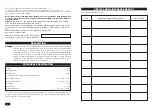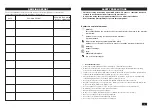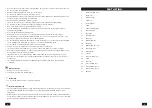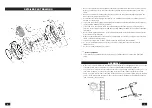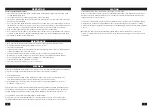
Correct operation and control
•
If you pulled out sufficient cable length, continue pulling it slowly until you hear "click". The cable is now
secured against reeling back.
•
If you need longer cable, continue puling it, until you hear "click" again.
•
If you want to wind the cable back, pull it out about 400 mm until you hear "click". Then release the cable
and it will reel in automatically.
•
Do not help the cable during the reverse reeling action. The cable turns on the spindle may get loose and
the cable will not be wound up properly. In such case you must pull the cable out completely and let it reel
in again. That way you prevent cable deformation and ensure correct cable storage on the spindle.
•
Hold the cable slightly during reverse reeling to prevent injuries due to a cable swing.
•
Do not attempt to reel the cable in cold environment as cold cable looses its flexibility. Move the cable set
to a warm room. Make sure to bend the cable in large radiuses to prevent cable damage. Reel the cable
back in after it reached its usual temperature.
•
Before performing any maintenance make sure the cable is disconnected from the wall outlet.
•
Protect the cable from water to prevent injuries by electric current.
•
Inspect the cable regularly.
•
Clean dirty cable or the covers of the cable set with neutral cleaning solution or alcohol. Using aggressive
solutions may damage the cable or the covers.
•
Store the cable in dry and safe place to ensure its perfect conditions and long operational life.
•
Maintain your tools clean. Dirt may enter the inner mechanism of your machine and cause damage.
•
Do not use aggressive cleaning solution or paint thinners to clean the machine.
•
Clean plastic parts with cloth dipped in soup water.
•
If you are not using your equipment, store it in a dry place.
When the operational life of your device is over, dispose off it in accordance with valid rules and regulations.
Your product is made of metal and plastic parts that may be recycled when separated.
1. Disassemble all parts.
2. Separate all parts according to the material they are made of (e.g. metals, rubber, plastics, etc.).
Take the separated parts to the recycling facility near you for further processing.
3. Electrical waste (used electrical power tools, electric motors, recharging equipment, electronics,
accumulators, batteries etc.).
Dear customer. In accordance with the valid regional rules and regulations describing the management of
electrical waste, electrical waste is considered dangerous. Disposal of electrical waste must be therefore
handled as dangerous waste in accordance with waste management rules valid in the state you are in.
It is prohibited to mix electrical waste with regular household waste.
You may return your used electrical appliance to a recycling facility near you. More information about
electrical and dangerous waste disposal may be obtained from your local authority or from the Internet.
6
DISPOSAL
OPERATION
MAINTENANCE
7
If the machine breaks down, send it back to the vendor for quick repair.
Please, enclose brief description of the defect. That makes repair easier. If the machine is still covered by
warranty, enclose the warranty card and proof of purchase receipt. After the warranty period expires, we
repair your machine for a special price.
To prevent possible damages during shipping, packed the machine carefully or use the original packaging
material. We are not liable for shipping damages due to incorrect packaging of your machine. If making
a claim at the shipping company the level and method of packaging plays a major role during claim evaluation
process.
Note:
Pictures and contents in this manual may slightly differ from the actual product or accessories.
It is due to continuous improvement of our products. Such small differences have no effect on the product
functionality.
CAUTION


